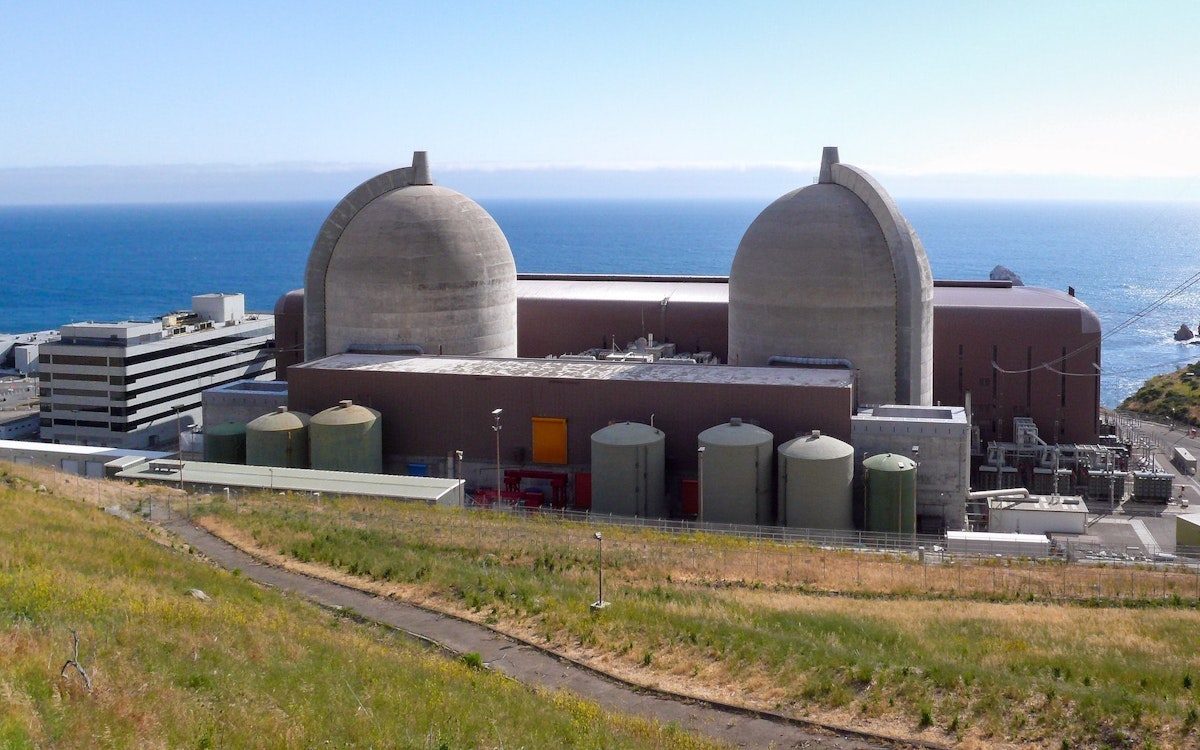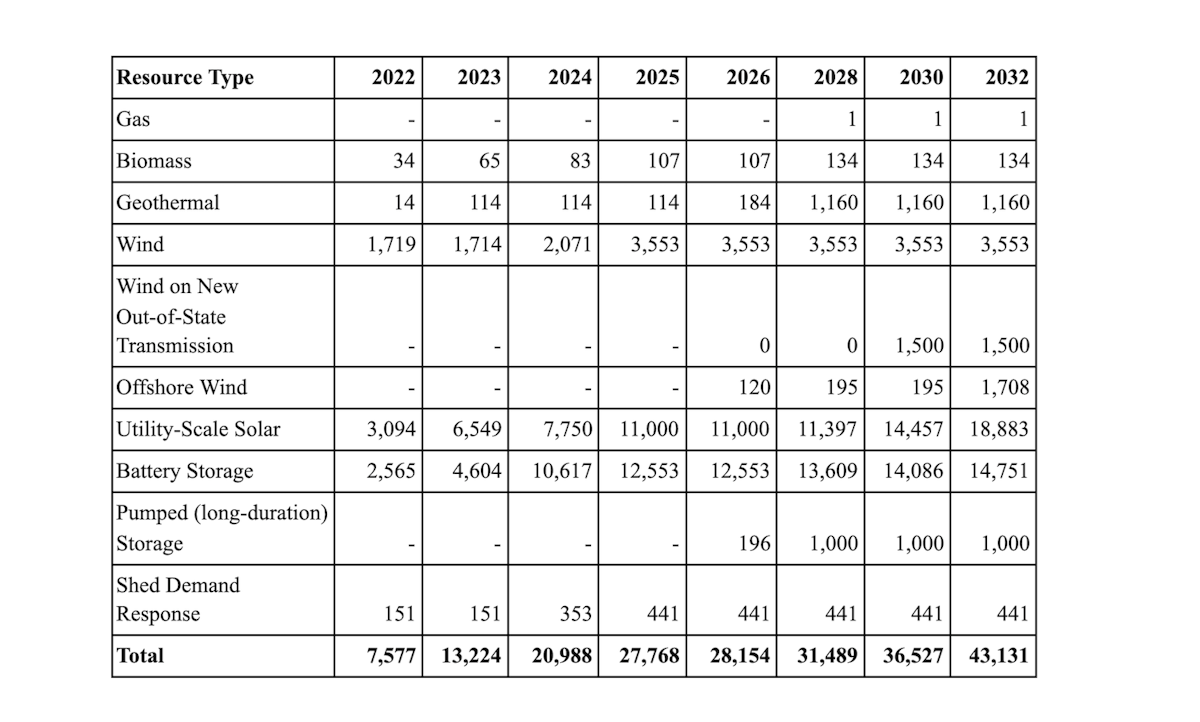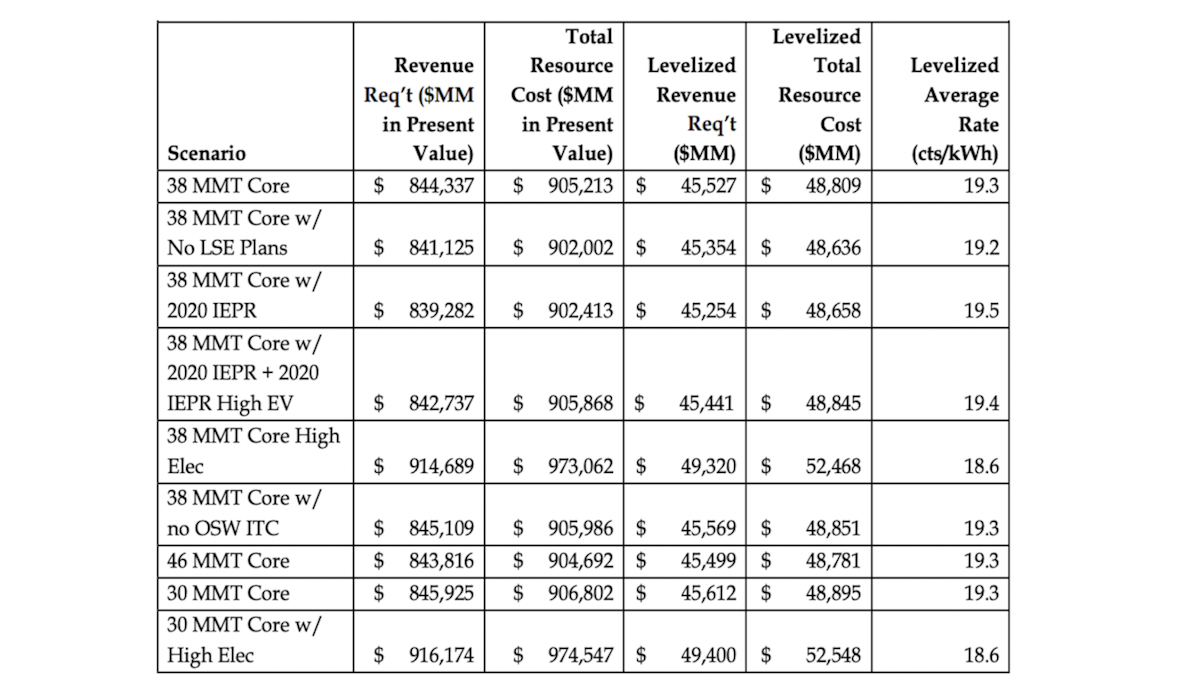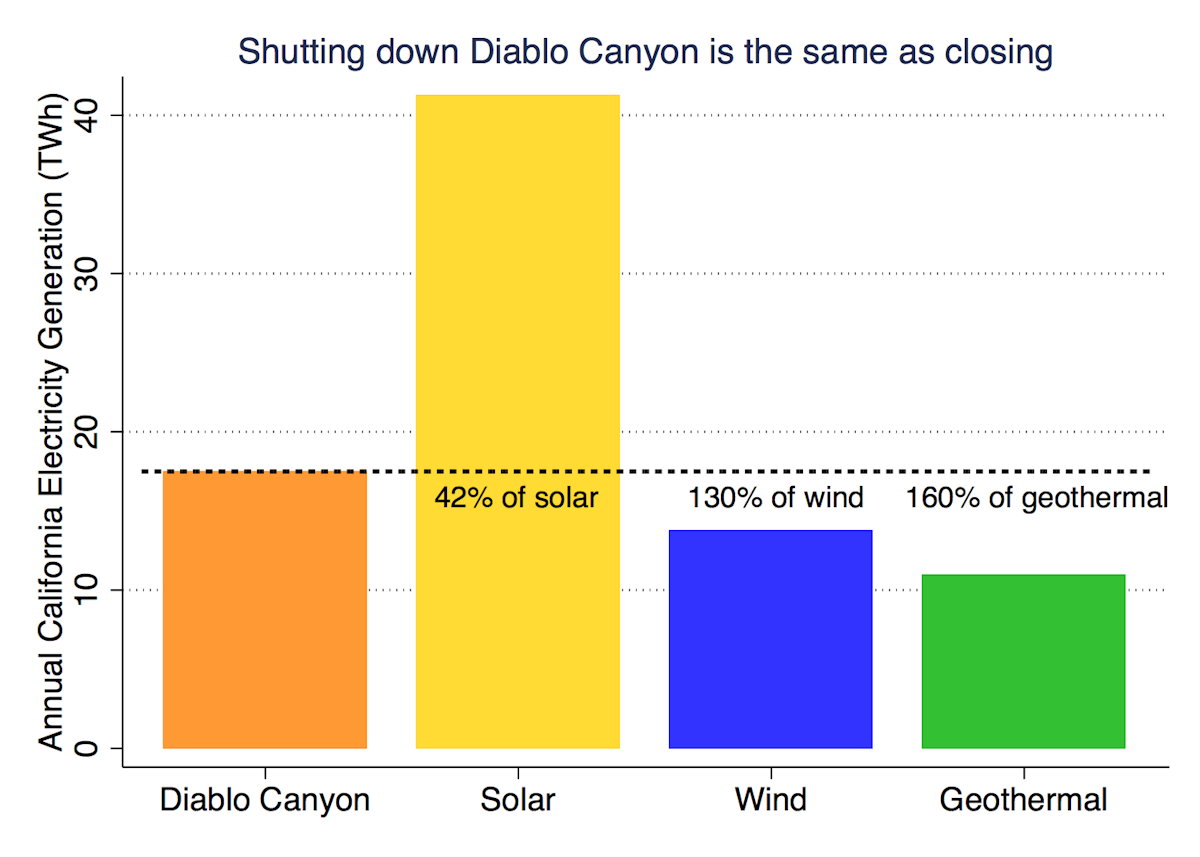If California Is Serious about Its Clean Energy Future, Shutting Down Diablo Canyon Needs to Be Reconsidered

-
-
Share
-
Share via Twitter -
Share via Facebook -
Share via Email
-
As a party to the CPUC integrated resources planning rulemaking process, the Breakthrough Institute recently submitted a comment related to the future of electricity in California, including the planned closure of Diablo Canyon Nuclear Power Plant. The following article outlines the Breakthrough Institute’s position and provides additional context.
As the California Public Utility Commission (CPUC) works to transition California to clean electricity by 2045, it should direct special focus to maintaining the CA electricity grid’s reliability while switching to a carbon-free energy system. Absent significant changes, the ability to both maintain California’s electricity reliability while pushing for sustainability requires the continued operation of Diablo Canyon nuclear power plant (DCPP) past its 2025 retirement date.
That nuclear energy plays a key role in enabling power sector decarbonization should come as no surprise. The International Energy Agency (IEA), the United Nations (UN), Intergovernmental Panel on Climate Change (IPCC), and many other organizations have concluded that the world needs nuclear power to meet collective climate goals. The IPCC reports that nuclear power contributes less carbon dioxide over the lifecycle than almost every other generation technology, including utility-scale solar. Additionally, nuclear power contributes fewer criteria pollutants, such as nitrogen oxides and sulfur dioxide, than other generation technologies. These benefits are all highly relevant to California’s climate and environmental aspirations.
Indeed, California’s net-zero energy grid goals are possible, but only with the kind of clean, firm energy that nuclear power provides. Studies have found that decarbonizing an electrical grid with large amounts of solar or wind is contingent on sufficient storage capacity, as the production of energy from renewables such as solar is cyclical and not always in alignment with energy needs. Winter evenings require more energy than solar can provide if the system is optimized for the summer, for example. Yet California is set to phase out DCPP, the state’s last nuclear power facility, at a time when the state lacks anywhere near the required quantity of storage or clean firm power to fill the void left behind.
How we got here
DCPP’s impending fate stems from a long history of double standards that have paradoxically treated nuclear plants more harshly than polluting fossil energy sources. For instance, DCPP’s use of a once-through cooling (OTC) has attracted longstanding criticism. Concerns over cooling water requirements seem legitimate at face value. California’s ongoing drought has severely limited hydroelectric production this year, and the IPCC projects that drought conditions will become increasingly common in the years ahead. Yet an ocean-based OTC system like DPCC’s offers superior resilience to drought or extreme heat waves by providing a nearly inexhaustible water supply at a relatively constant temperature. Meanwhile, legal exemptions continue to be granted for fossil gas plants utilizing once-through cooling. Even now, the State Water Board is finalizing an amendment to the OTC policy to further extend exemptions for gas plants in the name of maintaining grid reliability.
Such favoritism for gas over nuclear is the rule, not an exception. The CPUC procurement ruling for mid-term reliability (MTR) in June of this year openly expressed concerns about the reliability of the system after DPCC’s closure without new natural gas generation. Since the MTR decision, many supply shortages have prompted state-level emergency orders and requests for emergency relief from the Department of Energy to ignore environmental emissions limits. New gas plants now provide emergency generation despite major pressure by environmental groups to exclude them from the MTR ruling.
Yet both environmental groups and the CPUC have shown great willingness to entertain the fantasy that DPCC is being replaced with clean energy. Governor Newsom and the California legislature have passed SB 1090, nominally requiring the state to “avoid any increase in emissions of greenhouse gases as a result of the retirement of the Diablo Canyon nuclear power plant.” Since the addition of supplementary gas power electricity generation was added outside of the MTR process, the CPUC can claim that it has ordered entirely clean resources to replace Diablo Canyon. The five-year operation license for the new gas plants extends beyond the proposed retirement of DCPP. And while the CPUC MTR decision procures clean resources including clean firm generation, long-term storage, and resources that are available daily at peak periods to comply with SB 1090, the current preferred system plan (PSP) is unlikely to prove sufficient to meet proposed state greenhouse gas emissions targets. At any rate, even an idealized execution of DPCC’s retirement would result in little more than treadmill decarbonization: the replacement of one clean energy source with another, instead of the use of new clean energy to eliminate existing fossil fuel generation.
To replace a clean, firm resource like DCPP while maintaining reliability, other similar energy sources must already be in place. Firm zero-carbon resources are necessary to meet reliability requirements, namely a very high availability factor over a ten-year period even during continuous 100-hour low-renewable-energy production and grid contingencies as reflected in the 1-in-10-year standards. The already strained California’s energy grid requires firm energy to function properly and cannot afford to wait four years between the loss of one clean firm source (DCPP) and the arrival of ordered (but not yet sited or contracted) replacements. This correlates with comments made by several parties on the MTR decision arguing that the timeline is insufficient given likely long lead times for new projects. This worry would be negated by keeping DCPP open.
The 1000 MW of clean, firm resources ordered as part of the replacement for DCPP in the MTR would arrive too late even if completed on schedule to come online in 2026, yet this outcome is unlikely given that the PSP has pushed the project back to 2028. This was expected, as the CPUC and several of the commenting parties expressed concerns in the MTR about the ability to get that level of geothermal online by 2026. It is unlikely the new geothermal resources can be accelerated, given that the moderate timeline for geothermal development is 7-9 years.
Even if the 1,000 MW of clean firm geothermal were forced to be online by 2026, the PSP found in a sensitivity analysis that system reliability would fall just slightly short of meeting reliability standards. Shifting paired solar and short-term storage facilities to come online sooner produced little effect. Once again, these results clearly indicate that more clean firm generation is necessary. After the PSP was released, several load serving entities (LSE) provided their own analysis suggesting that less, not more, clean energy and storage is needed than ordered in the MTR and that reduced capacity and storage would still result in a reliable system. It is clear that all of the provided analyses cannot be simultaneously true, but may describe some potential outcomes in a range of possible outcomes. The range of stakeholder analysis results clearly indicates that small changes in input assumptions can drastically change the results. That means the results are not stable (robust) to uncertainty and the boundaries of the range of outcomes must be determined. Now is obviously not the time to retire DCPP, yet state policymakers seem determined to employ motivated reasoning to reconcile DCPP’s closure with climate and grid reliability goals. It is imperative that this IRP should not inadvertently adversely impact the already distressed electricity system.
The (un)reliability of California's energy grid
The concerns over grid reliability represent major red flags. The CPUC is struggling to address several issues that have given even some developers pause. To address the reliability inadequacy in the PSP, CPUC added significant amounts of additional solar and storage to the PSP core model. The MTR has already ordered 11.5 GW of new resources, with 10.5 GW of that potentially sourced from various combinations of renewables and storage. The PSP proposes an even larger buildout of 14.5 GW of solar and wind accompanied by 12.5 GW of short-duration battery storage by 2026 — a nearly 40% increase in renewables from the MTR.
The supply pipeline simply may not accommodate the necessary rapid growth of PV solar and batteries. For example, the PSP projects a new buildout of nearly 15,000 MW of short-term battery storage capacity, illustrated in Table 2. The new buildout is planned as 4-hour duration storage, implying 59 GWh of storage — more than the total combined global production of stationary storage systems in 2022 of 50 GWh according to a battery storage industry source.
Table 1. New Resource Buildout of 38 MMT Core (Cumulative MW)

Meanwhile, no significant additional long-term storage is included in the PSP (only 196 MW), despite procurement of 1000 MW ordered in the MTR, leaving California reliant on outside electricity imports for seasonal reliability. Access to electricity imports from surrounding states is becoming increasingly unreliable, with wildfires threatening transmission lines and other climate challenges such as heatwaves limiting available supply. At the same time, the need for statewide grid demand response is expected to triple in the PSP.
Table 2. Scenario Cost Metrics

Relying upon further large-scale solar deployment in a state with considerable existing solar generation seems a questionable choice in terms of efficient policy. Research shows that as more solar is added to an electricity system its incremental capacity contribution declines. Policymakers should also consider potential costs. The PSP analysis shows that, despite claims made by many environmental groups, adding large amounts of solar and storage and shutting down nuclear plants does not reduce the cost to ratepayers. In most cases, especially the high electrification case and the more ambitious 30 MMT emission reduction case, the costs are slightly increased. Both of these cases will become more important as the population shifts to electric vehicles and adds air conditioning to residences in response to extreme heat events, and as the state strengthens efforts to reduce emissions. Closing Diablo Canyon will also increase the midterm cost of capacity according to the PSP. The higher cost of capacity and the underlying drivers and constraints will make it more difficult to add sufficient capacity if another generation shortage occurs in the future. This is coupled with the projected decline in operational reserve margin, that may dip below 20% in 2025-2026 due to the closing of DCPP.
Additional grid upgrades are also needed to accommodate the expected “greater sensitivity to voltage instability, especially as PG&E integrates more renewable generation onto the grid.” Ratepayers will see increased costs from transmission overhauls, even if generated electricity itself seems cheaper on paper. Higher costs could present barriers to the adoption of life-saving clean technologies, especially for disadvantaged communities that are already experiencing energy poverty, as cited in Nature Portfolio Journal. Multiple studies have shown that system-wide costs are lowest when clean, firm generation makes up a large portion of the electricity system.
Closing Diablo Canyon under CEPP
Congressional Democrats have proposed, but have not yet passed, a Clean Energy Performance Program (CEPP) as a key part of the climate change mitigation measures in their budget reconciliation bill. CEPP incentivizes states to deploy low-carbon electricity generation and prevent them from closing existing low-carbon facilities prematurely such as Diablo Canyon. The proposed program establishes a system of financial incentives and penalties depending on year-to-year changes in a utility’s clean energy portfolio with 2019-2020 as the program’s baseline. By putting dollar amounts to the climate and environmental value of clean electricity generation, the CEPP further emphasizes how costly and unproductive DCPP’s retirement would be.
As we recently detailed, PG&E would incur penalties of approximately $600 million across the two years over which DCPP is retired, with total penalties increasing to $1 billion by 2030, as continued penalties of missing the 4% year-over-year clean energy growth target accumulate until PG&E brings clean energy generation back up to its baseline levels. The fact that clean energy has to be added in the same year that DCPP is replaced to avoid incurring large fines makes the decision to close the reactor particularly costly under the CEPP framework even if PG&E pursues accelerated adoption of clean energy replacements.
In addition, closing Diablo puts PG&E at risk of missing out on approximately $500 million in incentives they could receive by going from 89% clean energy to 100% clean energy under the CEPP, if PG&E is unable to both fill in the gap left by closing Diablo and get all the way back up to 100% before the program ends in 2031. If we use the actual current procurement of 71% clean energy — which accounts for PG&E gas generation sold to CAISO — the incentives at risk could be as large as ~$1.5 billion.
As mentioned earlier, even if DCPP is successfully replaced with other clean energy sources, the switch will not contribute to the overall decarbonization of the electricity system. DCPP currently produces more than twice the sum of all wind generation or close to half of all solar generation in the state. And unlike DCPP, the wind and solar resources are intermittent and therefore provide less per-unit value to the system overall.
Figure 1

Solar generation is concentrated in a relatively short period of the day, which means that it is particularly susceptible to a phenomenon known as value deflation. As more solar generation is installed, the average wholesale price of electricity decreases during mid-day hours. This reduces the value of both new and existing solar compared to other electricity sources that are better matched.
As a result, we find that some degree of future subsidies — either in the form of current tax incentives or future nominally technologically neutral mechanisms like carbon pricing or a clean energy standard — will likely be needed to sustain the cost-effective deployment of the high levels of solar over the next three decades projected by the California Energy Commission. This dynamic is likely to persist even if the expansion of complementary technologies like long-distance transmission, storage, and demand response can partially mitigate solar value deflation.
Deployment of additional solar resources will become increasingly difficult as values deflate. The laudable rapid expansion of clean energy sources ordered by the CPUC should be deployed with the intention of retiring and removing fossil fuel-based generation, which still makes up the majority of electricity generation in California. The CPUC risks missing the opportunity to offset fossil fuels now, in order to fill the gap left behind by unnecessarily retiring DCPP.
As currently formulated, the CPUC’s proposed PSP risks committing California to a plan for the state’s electricity sector that fails to meet both public needs and environmental goals. The draft plan makes highly overoptimistic assumptions regarding the scale of a statewide solar and storage buildout, understates costs and challenges associated with its chosen approach, fails to account for Diablo Canyon’s true value in grid reliability and climate terms, and implicitly favors increased medium-term reliance on fossil fuels as an acceptable outcome following Diablo Canyon’s closure. Every indication suggests that the CPUC should carefully review both its medium-term grid reliability planning and its decision to force Diablo Canyon’s retirement.


